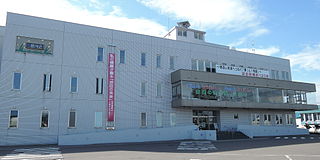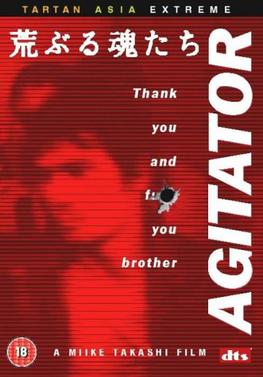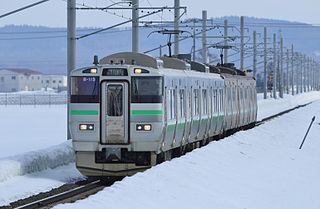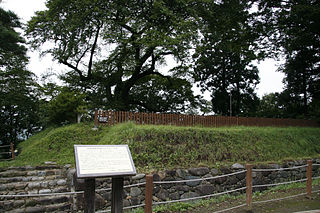Related Research Articles

Xuanzang, born Chen Hui / Chen Yi, colloquially also known as Hsiuen Tsang and by his Sanskrit Dharma name Mōkṣadeva, was a 7th-century Chinese Buddhist monk, scholar, traveler, and translator. He is known for the epoch-making contributions to Chinese Buddhism, the travelogue of his journey to India in 629–645 CE, his efforts to bring over 657 Indian texts to China, and his translations of some of these texts.

Numata is a city located in Gunma Prefecture, Japan. As of 31 July 2020, the city had an estimated population of 46,908 in 20,589 households, and a population density of 110 persons per km². The total area of the city is 443.46 square kilometres (171.22 sq mi), making it the largest city in terms of area within Gunma Prefecture.

Sanada Masayuki was a Japanese Sengoku period lord and daimyō. He was the head of Sanada clan, a regional house of Shinano Province, which became a vassal of the Takeda clan of Kai Province.

Kawaba is a village located in Gunma Prefecture, Japan. As of 31 October 2020, the village had an estimated population of 3,241 in 1127 households, and a population density of 110 persons per km². The total area of the village is 85.25 square kilometres (32.92 sq mi).

Shōwa is a village located in Gunma Prefecture, Japan. As of 1 October 2020, the village had an estimated population of 7,228 in 2751 households, and a population density of 110 persons per km². The total area of the village is 64.14 square kilometres (24.76 sq mi).

The Family Game is a 1983 Japanese movie directed by Yoshimitsu Morita. The Family Game received several awards including the best movie of the year as selected by Japanese critics. Although the movie missed the Japan Academy Prize for the Best Picture, Ichirōta Miyagawa was awarded Newcomer of the Year.

Numata is a town located in Sorachi Subprefecture, Hokkaido, Japan.

Agitator is a 2001 Japanese film directed by Takashi Miike.

Transient receptor potential cation channel subfamily M member 1 is a protein that in humans is encoded by the TRPM1 gene.

AT-rich interactive domain-containing protein 3B is a protein that in humans is encoded by the ARID3B gene.

Protein reversionless 3-like (REV3L) also known as DNA polymerase zeta catalytic subunit (POLZ) is an enzyme that in humans is encoded by the REV3L gene.

Leucine zipper putative tumor suppressor 1 is a protein that, in humans, is encoded by the LZTS1 gene.

Sodium/hydrogen exchanger 6 is an integral membrane protein that in humans is encoded by the SLC9A6 gene. It was originally thought to be a mitochondrial-targeted protein, but subsequent studies have localized it to the plasma membrane and recycling endosomes.

Fissipunctia ypsillon, the dingy shears, is a species of moth of the family Noctuidae. It is found in the Palearctic realm.

Mammals normally have a pair of eyes. Although mammalian vision is not so excellent as bird vision, it is at least dichromatic for most of mammalian species, with certain families possessing a trichromatic color perception.

The Sasshō Line is a railway line in Japan operated by Hokkaido Railway Company, which connects Sōen in Sapporo and Hokkaidō-Iryōdaigaku in Tōbetu, Ishikari District. Its name is made up of two characters from Sapporo (札幌) and Ishikari-Numata (石狩沼田), the latter of which was the terminus of the line until it was relocated to Shin-Totsukawa in 1972.
Keigo Numata is a Japanese football player who plays for FC Ryukyu.

Numata Domain was a feudal domain under the Tokugawa shogunate of Edo period Japan, located in Kōzuke Province, Japan. It was centered on Numata Castle in what is now the city of Numata, Gunma.

Numata Castle is a Japanese castle located in Numata, northern Gunma Prefecture, Japan. At the end of the Edo period, Numata Castle was home to the Toki clan, daimyō of Numata Domain, but the castle was ruled by various clans over its history, and is noted as the site of a major battle in the Sengoku period. The castle was also known as "Kurauchi-jō" (倉内城).
Miobalaenoptera is an extinct genus of rorqual from the Late Miocene (Messinian) of Japan.